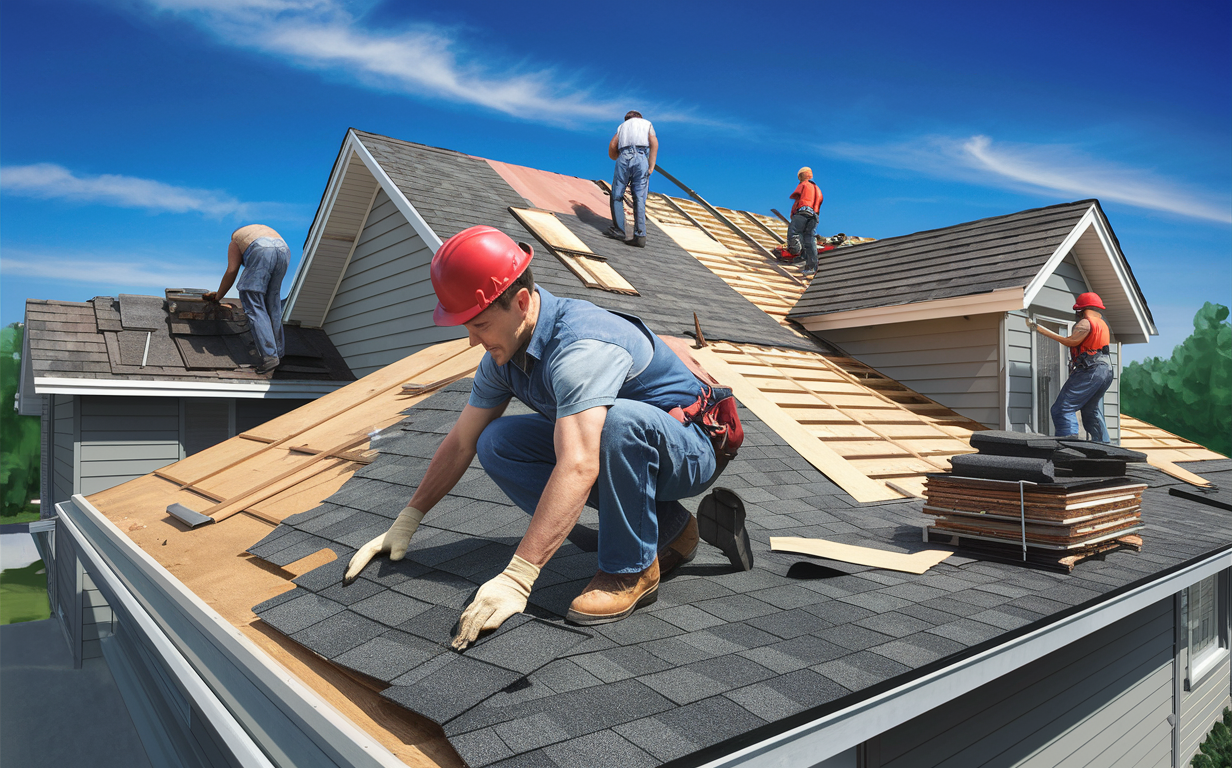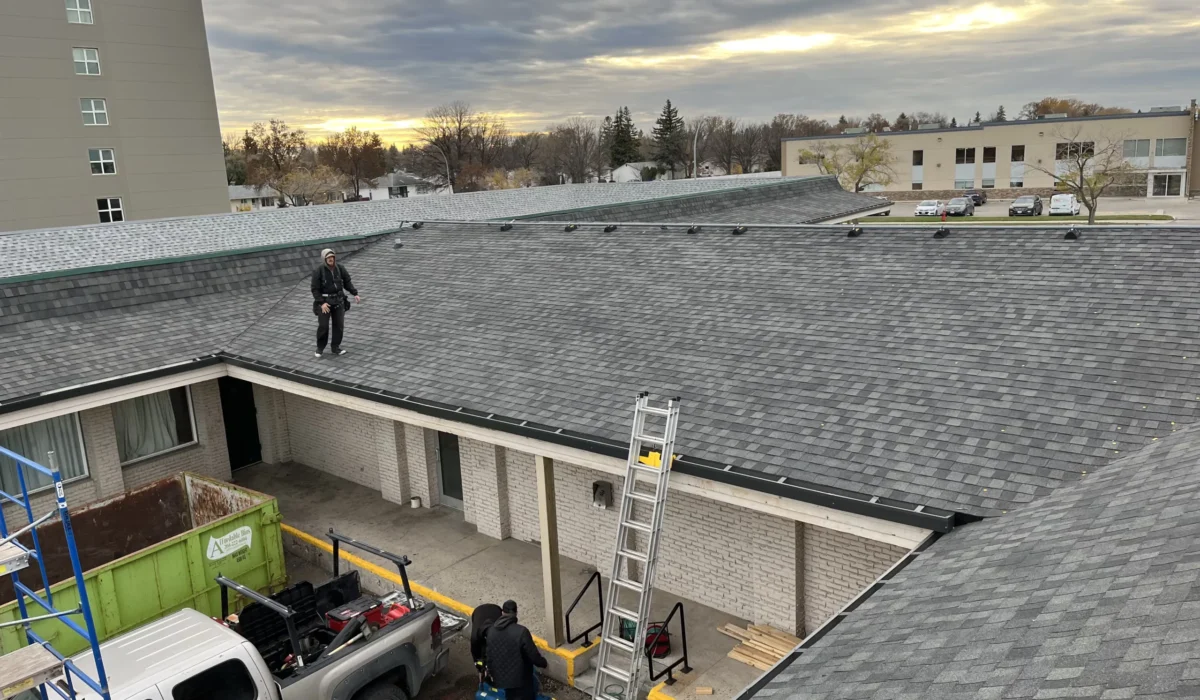When faced with a deteriorating roof, it’s essential to understand the process of roof replacement to make informed decisions. A roof replacement not only protects your home but also enhances its overall value and curb appeal.
Key Takeaways
- Roof replacement is crucial for maintaining your home’s integrity.
- It involves removing the old roof and installing a new one using high-quality materials.
- Proper planning and choosing the right materials can extend the lifespan of your new roof.
- Regular maintenance can prevent the need for frequent replacements.
Understanding Roof Replacement
Why Roof Replacement is Essential
Roof replacement is necessary when your existing roof has sustained extensive damage or wear over time. Ignoring the signs of a failing roof can lead to severe structural problems and costly repairs. A new roof ensures that your home remains safe from the elements and maintains its value.
Signs You Need a Roof Replacement
Knowing when to replace your roof can save you from unexpected expenses. Here are some signs that indicate it’s time for a new roof:
- Frequent leaks: Persistent water leaks can cause significant damage to your home’s interior.
- Missing shingles: Shingles that are missing, cracked, or curling are a clear sign of deterioration.
- Moss and mold growth: Excessive moss and mold can compromise the roof’s structure.
- Sagging roof: A sagging roof deck indicates severe structural damage.
Choosing the Right Roofing Material
Selecting the appropriate roofing material is crucial for the durability and aesthetics of your home. Here are some common materials and their benefits:
| Material | Benefits | Lifespan |
|---|---|---|
| Asphalt Shingles | Affordable, easy to install, widely available | 20-30 years |
| Metal Roofing | Durable, energy-efficient, low maintenance | 40-70 years |
| Slate Tiles | Extremely durable, fire-resistant, elegant | 75-200 years |
| Wood Shakes | Natural appearance, good insulation | 30-50 years |
Cost Factors in Roof Replacement
The cost of roof replacement varies based on several factors. It’s essential to understand these factors to budget effectively for your project.
Size and Complexity of the Roof
Larger and more complex roofs require more materials and labor, increasing the overall cost. Features like dormers, chimneys, and skylights add to the complexity.
Type of Roofing Material
Different materials come with varying costs. For instance, slate tiles are more expensive than asphalt shingles. Choosing premium materials can significantly impact your budget.
Labor Costs
Labor costs vary by region and the roofing contractor’s expertise. Hiring experienced professionals ensures quality work but may come at a higher price.
Additional Repairs
If your roof deck or underlying structures are damaged, additional repairs will be necessary, adding to the total cost.
Roof Replacement Process
Understanding the roof replacement process helps you prepare for what to expect. Here’s a step-by-step overview:
- Inspection and Assessment: A thorough inspection identifies the extent of damage and determines the necessary repairs.
- Removal of Old Roof: The old roofing material is removed, and any damaged decking is replaced.
- Installation of Underlayment: An underlayment is installed to provide a waterproof barrier.
- Installation of New Roof: New roofing materials are installed, starting from the bottom and working upwards.
- Cleanup and Inspection: The site is cleaned, and a final inspection ensures the roof’s integrity.
Benefits of Roof Replacement
Replacing your roof offers several advantages beyond just fixing leaks and damage:
Increased Home Value
A new roof enhances your home’s curb appeal and can increase its market value. Potential buyers view a new roof as a significant investment, making your property more attractive.
Energy Efficiency
Modern roofing materials improve energy efficiency by providing better insulation. This can lead to lower heating and cooling costs, saving you money in the long run.
Enhanced Safety
A sturdy roof protects your home from the elements, preventing water damage, mold growth, and structural issues.
Peace of Mind
Knowing your roof is in excellent condition gives you peace of mind, especially during extreme weather conditions.
Maintenance Tips for Longevity
Regular maintenance can extend the lifespan of your new roof and prevent minor issues from becoming major problems. Here are some tips:
- Regular Inspections: Have your roof inspected at least once a year to catch any potential problems early.
- Clean Gutters: Keep gutters clean to prevent water buildup and damage to the roof’s edge.
- Trim Overhanging Branches: Overhanging branches can damage shingles and allow pests access to your roof.
- Address Repairs Promptly: Fix minor issues promptly to prevent them from escalating.
Common Roof Replacement Myths
There are several myths surrounding roof replacement that can mislead homeowners. Let’s debunk some common misconceptions:
Roof Replacement is Always Expensive
While roof replacement can be costly, it’s an investment that pays off in the long run. Proper planning and material choices can help manage costs.
Any Roofing Contractor Will Do
Choosing a reputable and experienced roofer is crucial for quality work. Not all contractors have the same level of expertise.
Roof Replacement is a DIY Project
Roof replacement is a complex and dangerous the best left to professionals. DIY attempts can lead to improper installation and safety harazards.
Roof Replacement and Home Insurance
Understanding how roof replacement affects your home insurance can help you navigate the process more smoothly:
Insurance Coverage
Many home insurance policies cover roof replacement if the damage is due to a covered peril, such as a storm. It’s essential to review your policy and understand the coverage details.
Filing a Claim
If your roof replacement is covered by insurance, you’ll need to file a claim. Provide documentation, including photos and estimates, to support your claim.
Impact on Premiums
A new roof can potentially lower your insurance premiums. Insurance companies view new roofs as less risky, which can result in savings on your policy.
Environmental Considerations
Roof replacement offers an opportunity to consider environmentally friendly options:
Recyclable Materials
Choose roofing materials that can be recycled at the end of their lifespan, reducing environmental impact.
Energy-Efficient Options
Opt for energy-efficient roofing materials that help reduce your home’s energy consumption, contributing to a greener environment.
DIY vs. Professional Roof Replacement
While some homeowners consider DIY roof replacement to save money, it’s essential to weigh the pros and cons:
DIY Roof Replacement
Pros: – Potential cost savings on labor – Sense of accomplishment
Cons: – Safety risks – Lack of expertise – Potential for improper installation
Professional Roof Replacement
Pros: – Expertise and experience – Quality workmanship – Warranty and guarantees
Cons: – Higher upfront cost
Maintaining Your New Roof
Once your roof is replaced, proper maintenance ensures its longevity:
Regular Inspections
Schedule annual inspections to catch any issues early and keep your roof in top condition.
Prompt Repairs
Address any damage or leaks promptly to prevent further problems.
Cleaning and Debris Removal
Keep your roof clean and free of debris to prevent damage and ensure proper drainage.
Key Steps in Roof Replacement
| Step | Description |
|---|---|
| Inspection | Thorough assessment of current roof condition |
| Material Selection | Choosing suitable materials for your needs |
| Removal | Safe removal of old roofing materials |
| Installation | Professional installation of new roof |
| Final Inspection | Ensuring the roof is properly installed |
List of Common Roofing Materials

- Asphalt shingles
- Metal roofing
- Slate tiles
- Wood shakes
- Clay tiles
- Concrete tiles
Conclusion
Replacing your roof is a significant investment that ensures the safety and value of your home. By understanding the process, costs, and benefits, you can make informed decisions and choose the best materials and professionals for the job. Regular maintenance and prompt repairs will keep your new roof in excellent condition for years to come.
For top-quality roofing services in Winnipeg, trust Zega Roofing to provide expert craftsmanship and reliable solutions. Contact us today for a free consultation and discover how we can protect your home with our exceptional roofing services.


